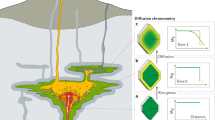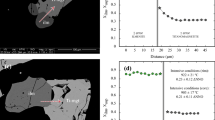Abstract
Complex crystal cargo in basaltic eruptions has the potential to yield diverse insights on pre- and syn-eruptive timescales of magma storage and transport. Research on eruption products from the 1959 eruption from Kīlauea Iki Crater at Kīlauea volcano (Hawai‘i) demonstrates that time-series samples collected during an eruption can yield a wealth of information not accessible by studying the fall deposit alone. Major element zoning in olivine crystals illustrates four environments of magma storage that were variably mixed and progressively involved in the eruption. Diffusion timescales retrieved from crystals < 1 mm in size are typically much shorter than those from crystals > 1 mm, illustrating the additional complexity of information recorded by different grain sizes and olivine populations. The timescales can be divided into two groups: (1) t > 100 days reflect longer-term magma recharge into Kīlauea’s deep (8–10 km) reservoir system and (2) t < 100 days broadly correspond to a period of unrest and inflation beginning ~ 3 months prior to eruption. Some timescales reflect syn-eruptive processes, where diffusion began after the eruption onset. Progressive changes in zoning populations in the time-series scoriae samples illustrate how quickly diffusive re-equilibration can erase older magmatic histories and information and underscores that studies on fall deposits can lead to an incomplete record of magmatic processes. Thus, diffusion timescales from fall deposits alone should be cautiously interpreted with the caveat that they may be missing a substantial part of the total eruptive event and, therefore, the record of magmatic histories inferred from crystal cargo.










Similar content being viewed by others
References
Albert H, Costa F, Martí F (2016) Years to weeks of seismic unrest and magmatic intrusions precede monogenetic eruptions. Geology 44:211–214. https://doi.org/10.1130/G37239.1
Albert H, Costa F, Di Muro A, Herrin J, Métrich N, Deloule E (2019) Magma interactions, crystal mush formation, timescales, and unrest during caldera collapse and lateral eruption at ocean island basaltic volcanoes (Piton de la Fournaise, La Réunion). Earth Planet Sci Lett 515:187–199. https://doi.org/10.1016/j.epsl.2019.02.035
Bergantz GW, Schleicher JM, Burgisser A (2015) Open-system dynamics and mixing in magma mushes. Nat Geos 8:793–797. https://doi.org/10.1038/NGEO2534
Bradshaw RW, Kent AJR (2017) The analytical limits of modeling short diffusion timescales. Chem Geol 446:667–677. https://doi.org/10.1016/j.chemgeo.2017.07.018
Bradshaw RW, Kent AJR, Tepley FJ III (2018) Chemical fingerprints and residence times of olivine in the 1959 Kilauea Iki eruption, Hawaii: insights into picrite formation. Am Mineral 103:1812–1826. https://doi.org/10.2138/am-2018-6331
Caracciolo A, Kahl M, Bali E, Gudfinnsson GH, Halldorsson SA, Hartley ME (2021) Timescales of crystal mush mobilization in the Bárðarbunga-Veiðivötn volcanic system based on olivine diffusion chronometry. Am Mineral 106:1083–1096. https://doi.org/10.2138/am-2021-7670
Chakraborty S (2010) Diffusion coefficients in olivine, wadsleyite, and ringwoodite. Rev Mineral Geochem 72:603–639. https://doi.org/10.2138/rmg.2010.72.13
Cheng L, Costa F, Bergantz G (2020) Linking fluid dynamics and olivine crystal scale zoning during simulated magma intrusion. Cont Mineral Petrol 175:53. https://doi.org/10.1007/s00410-020-01691-3
Costa F, Shea T, Ubide T (2020) Diffusion chronometry and the timescales of magmatic processes. Nat Rev Earth Env 1:201–214. https://doi.org/10.1038/s43017-020-0038-x
Costa F, Morgan D (2011) Time constraints from chemical equilibration in magmatic crystals. In Dossesto A, Turner SP, Van Orman JA eds. Timescales of magmatic process from core to atmosphere. Wiley Blackwell, p. 125–159.
Couperthwaite FK, Thordarson T, Morgan DJ, Harvey J, Wilson M (2020) Diffusion timescales of magmatic processes in the Moinui lava eruption at Mauna Loa, Hawai‘i, as inferred from bimodal olivine populations. J Petrol 61:1–18. https://doi.org/10.1093/petrology/egaa058
Crank J (1975) The mathematics of diffusion, 2nd edn. Oxford Science Publications, Oxford
Dohmen R, Chakraborty S (2007a) Fe-Mg diffusion in olivine II: Point defect chemistry, change of diffusion mechanisms and a model for calculation of diffusion coefficients in natural olivine. Phys Chem Mineral 34:409–430. https://doi.org/10.1007/s00269-007-0158-6
Dohmen R, Chakraborty S (2007b) Erratum to: Fe-Mg diffusion in olivine II: point defect chemistry, change of diffusion mechanisms and a model for calculation of diffusion coefficients in natural olivine. Phys Chem Mineral 34:409–430. https://doi.org/10.1007/s00269-007-0158-6
Eaton JP, Richter DH, Krivoy HL (1987) Cycling of magma between the summit reservoir and Kilauea Iki lava lake during the 1959 eruption of Kilauea Volcano. In: Decker RW, Wright TL, Stauffer PH (eds) Volcanism in Hawaii. USGS Prof Pap 1350:1307–1335
Eaton JP, Murata KJ (1960) How volcanoes grow. Science 132:925–938. https://doi.org/10.1126/science/132.3432.925
Eggins SM (1991) Petrogenesis of Hawaiian tholeiites: 1, phase equilibria constraints. Cont Mineral Petrol 110:387–397. https://doi.org/10.1007/BF00310752
Helz RT (2020) Major-element compositional data and thermal data for drill core from the Kīlauea Iki lava lake, plus analyses of glasses from scoria of the 1959 summit eruption of Kīlauea Volcano. Hawaii USGS Open File Rep 2020–1012:1–48. https://doi.org/10.3133/ofr20201012
Helz RT, Thornber CR (1987) Geothermometry of Kilauea Iki lava lake. Bull Volcanol 49:651–668. https://doi.org/10.1007/BF01080357
Helz RT, Clague DA, Mastin LG, Rose TR (2015) Evidence for large compositional ranges in coeval melts erupted from Kīlauea’s summit reservoir. AGU Mono 208:125–145. https://doi.org/10.1002/9781118872079.ch7
Helz RT, Cottrell E, Brounce MN, Kelley KA (2017) Olivine-melt relationships and syneruptive redox variations in the 1959 eruption of Kīlauea Volcano as revealed by XANES. J Volcanol Geotherm Res 333–334:1–14. https://doi.org/10.1016/j.jvolgeores.2016.12.006
Helz RT (1987) Diverse olivine types in lava of the 1959 eruption of Kilauea Volcano and their bearing on eruption dynamics. In: Decker RW, Wright TL, Stauffer PH (eds) Volcanism in Hawaii. USGS Prof Pap 1350:691–722.
Helz RT (2022). Proportions, timing, and re-equilibration progress during the 1959 summit eruption of Kīlauea: an example of magma mixing processes operating during OIB petrogenesis. J Petrol 63:egab091 https://doi.org/10.1093/petrology/egab091
Hill DP, Zucca JJ (1987) Geophysical constraints on the structure of Kilauea and Mauna Loa volcanoes and some implications for seismomagmatic processes. In: Decker RW, Wright TL, Stauffer PH (eds) Volcanism in Hawaii. USGS Prof Pap 1350:903–917
Kahl M, Chakraborty S, Costa F, Pompilio M (2011) Dynamic plumbing system beneath volcanoes revealed by kinetic modeling, and the connection to monitoring data: an example from Mt. Etna Earth Planet Sci Lett 308:11–22. https://doi.org/10.1016/j.epsl.2011.05.008
Kahl M, Chakraborty S, Costa F, Pompilio M, Liuzzo M, Viccaro M (2013) Compositionally zoned crystals and real-time degassing data reveal changes in magma transfer dynamics during the 2006 summit eruptive episodes of Mt. Etna Bull Volcanol 75:692. https://doi.org/10.1007/s00445-013-0692-7
Kahl M, Chakraborty S, Pompilio M, Costa F (2014) Constraints on the nature and evolution of the magma plumbing system of Mt. Etna Volcano (1991–2008) from combined thermodynamic and kinetic modelling of the compositional records of minerals. J Petrol 56:2025–2068. https://doi.org/10.1093/petrology/egv063
Lerner AH, Wallace PJ, Shea T, Mourey AJ, Kelly PJ, Nadeau PA, Elias T, Kern C, Clor LE, Gansecki C, Lee RL, Moore LR, Werner CA (2021) The petrologic and degassing behavior of sulfur and other magmatic volatiles from the 2018 eruption of Kīlauea, Hawai‘i: melt concentrations, magma storage depths, and magma recycling. Bull Volcanol 83:43. https://doi.org/10.1007/s00445-021-01459-y
Lynn KJ, Garcia MO, Shea T, Costa F, Swanson DA (2017) Timescales of mixing and storage for Keanakāko‘i Tephra magmas (1500–1820 C.E.), Kīlauea Volcano, Hawai‘i. Cont Mineral Petrol 172:76 https://doi.org/10.1007/s00410-017-1395-4
Matzen AK, Baker MB, Beckett JR, Stolper EM (2011) Fe-Mg partitioning between olivine and high-magnesian melts and the nature of Hawaiian parental liquids. J Petrol 52:1243–1263. https://doi.org/10.1093/petrology/egq089
Montierth C, Johnston AD, Cashman KV (1995) An empirical glass-composition-based geothermometer for Mauna Loa lavas. In: Mauna Loa Revealed: Structure, Composition, History, and Hazards, Rhodes and Lockwood, Eds. AGU Monog 92:207–217
Moore LR, Gazel E, Tuohy R, Lloyd AS, Esposito R, Steele-MacInnis M, Hauri EH, Wallace PJ, Plank T, Bodnar RJ (2015) Bubbles matter: an assessment of the contribution of vapor bubbles to melt inclusion volatile budgets. Am Mineral 100:806–823. https://doi.org/10.2138/am-2015-5036
Mueller SB, Houghton BF, Swanson DA, Fagents SA, Klawonn M (2018) Intricate episodic growth of a Hawaiian tephra deposit: case study of the 1959 Kīlauea Iki eruption. Bull Volcanol 80:73. https://doi.org/10.1007/s00445-018-1249-6
Murata KJ, Richter DH (1966) Chemistry of lavas of the 1959–1960 eruption of Kīlauea volcano, Hawai‘i. USGS Prof Pap 537-A:1–26.
Mutch EJF, Maclennan J, Shorttle J, Edmonds M, Rudge JF (2019) Rapid transcrustal movement under Iceland. Nat Geosci 12:569–574. https://doi.org/10.1038/s41561-019-0376-9
Neal CA, et al. (2019) The 2018 rift eruption and summit collapse of Kīlauea Volcano. Science 7046:eaav7046. https://doi.org/10.1126/science.aav7046
Pankhurst MJ, Morgan DJ, Thordarson T, Loughlin SC (2018) Magmatic crystal records in time, space, and process, causatively linked with volcanic unrest. Earth Planet Sci Lett 493:231–241. https://doi.org/10.1016/j.epsl.2018.04.025
Rae ASP, Edmonds M, Maclennan J, Morgan D, Houghton B, Hartley ME, Sides I (2016) Time scales of magma transport and mixing at Kīlauea Volcano, Hawai‘i. Geology 44:463–466. https://doi.org/10.1130/G37800.1
Rasmussen DJ, Plank TA, Roman DC, Power JA, Bodnar RJ, Hauri EH (2018) When does the run-up to eruption begin? Multidisciplinary insight from the 1999 eruption of Shishaldin volcano. Earth Planet Sci Lett 486:1–14. https://doi.org/10.1016/j.epsl.2018.01.001
Richter DH, Eaton JP, Murata KJ, Ault WU, Krivoy HL (1970) Chronological narrative of the 1959–60 eruption of Kilauea Volcano, Hawai‘i. USGS Prof Pap 537-E:1–73.
Ryan MP (1988) The mechanics and three-dimensional internal structure of active magmatic systems: Kilauea volcano, Hawai‘i. J Geophys Res Solid Earth 93:4213–4248. https://doi.org/10.1029/JB093iB05p04213
Schwindinger KR, Anderson ATJr, (1989) Synneusis of Kilauea Iki olivines. Cont Mineral Petrol 103:187–198. https://doi.org/10.1007/BF00378504
Shea T, Costa F, Krimer D, Hammer JE (2015) Accuracy of timescales retrieved from diffusion modeling in olivine: a 3D perspective. Am Mineral 100:2026–2042. https://doi.org/10.2138/am-2015-5163
Sides I, Edmonds M, Maclennan J, Houghton BF, Swanson DA, Steele-MacInnis MJ (2014) Magma mixing and high fountaining during the 1959 Kīlauea Iki eruption, Hawai‘i. Earth Planet Sci Lett 400:102–112. https://doi.org/10.1016/j.epsl.2014.05.024
Stovall WK, Houghton BF, Harris AJL, Swanson DA (2009) A frozen record of density-driven crustal overturn in lava lakes: the example of Kīlauea Iki 1959. Bull Volcanol 71:313–318. https://doi.org/10.1007/s00445-008-0225-y
Stovall WK, Houghton BF, Gonnermann H, Fagents SA, Swanson DA (2011) Eruption dynamics of Hawaiian-style fountains: the case study of episode 1 of the Kīlauea Iki 1959 eruption. Bull Volcanol 73:511–529. https://doi.org/10.1007/s00445-010-0426-z
Stovall WK, Houghton BF, Hammer JE, Fagents SA, Swanson DA (2012) Vesiculation of high fountaining Hawaiian eruptions: episodes 15 and 16 of 1959 Kīlauea Iki. Bull Volcanol 74:441–455. https://doi.org/10.1007/s00445-011-0531-7
Swanson DA, Houghton BF (2018) Products, processes, and implications of Keanakāko’i volcanism, Kīlauea Volcano, Hawai‘i. Geol Soc Amer Spec Pap 538:159–190. https://doi.org/10.1130/2018.2536(07)
Swanson DA, Rose TR, Fiske RS, McGeehin JP (2012) Keanakāko’i Tephra produced by 300 years of explosive eruptions following collapse of Kīlauea’s caldera in about 1500 CE. J Volcanol Geotherm Res 215–216:8–25
Wagner TP, Grove TL (1998) Melt/harzburgite reaction in the petrogenesis of tholeiitic magma from Kilauea volcano. Hawaii Cont Mineral Petrol 131:1–12. https://doi.org/10.1007/s004100050374
Wallace PJ, Anderson AT (1998) Effects of eruption and lava drainback on the H2O contents of basaltic magmas at Kilauea Volcano. Bull Volcanol 59:327–344
Wright TL (1973) Magma mixing as illustrated by the 1959 eruption, Kilauea Volcano, Hawai‘i. Geol Soc Ameer Bull 84:849–858. https://doi.org/10.1130/0016-7606(1973)84%3c849:MMAIBT%3e2.0.CO;2
Acknowledgements
The time-series samples critical to many important conclusions of this study exist thanks to the dedication of USGS Hawaiian Volcano Observatory scientists who collected the scoriae samples in real time during the 1959 eruption. These samples are held and curated by the National Museum of Natural History, Smithsonian Institution, Washington, D.C. KJL thanks Wendy Stovall for the helpful discussions about the Kīlauea Iki ejecta blanket and the Volcano Science Center Writing Group for support. The manuscript was greatly improved by reviews from Wendy Stovall and three anonymous reviewers. Any use of trade, firm, or product names is for descriptive purposes only and does not imply endorsement by the U.S. Government.
Author information
Authors and Affiliations
Corresponding author
Additional information
Editorial responsibility: U. Kueppers
This paper constitutes part of a topical collection: What pyroclasts can tell us
Supplementary Information
Below is the link to the electronic supplementary material.
Rights and permissions
About this article
Cite this article
Lynn, K.J., Helz, R.T. Magma storage and transport timescales for the 1959 Kīlauea Iki eruption and implications for diffusion chronometry studies using time-series samples versus tephra deposits. Bull Volcanol 85, 3 (2023). https://doi.org/10.1007/s00445-022-01618-9
Received:
Accepted:
Published:
DOI: https://doi.org/10.1007/s00445-022-01618-9




